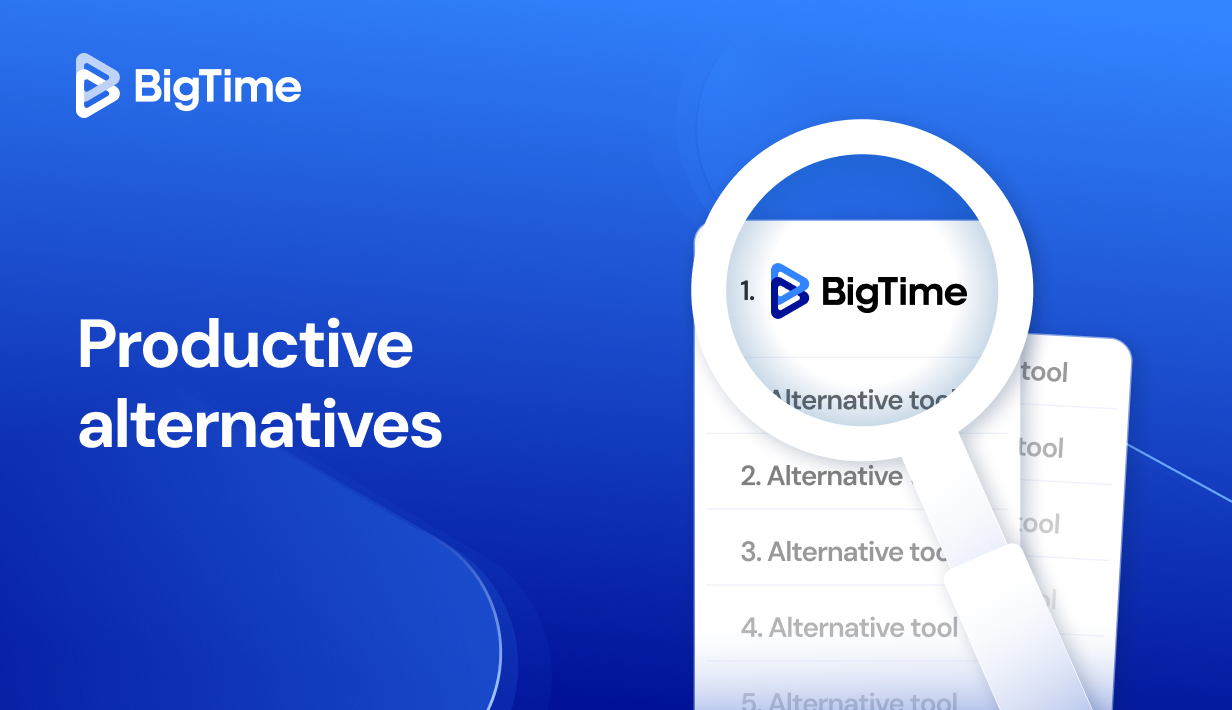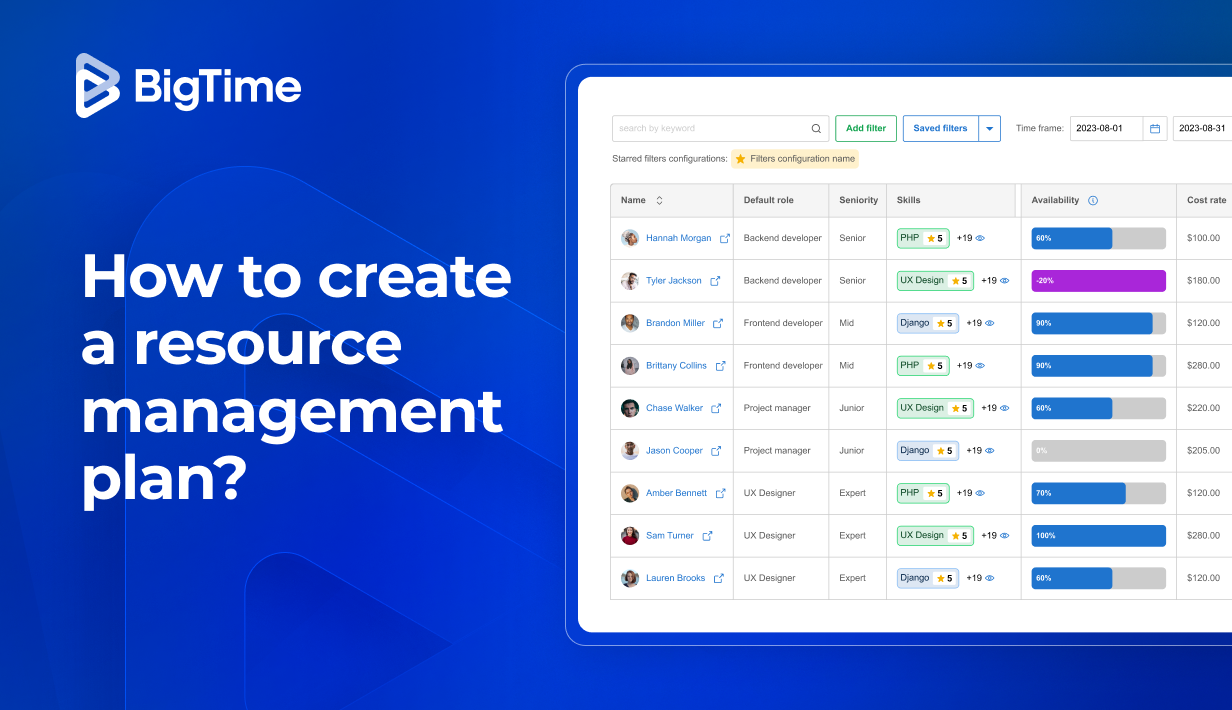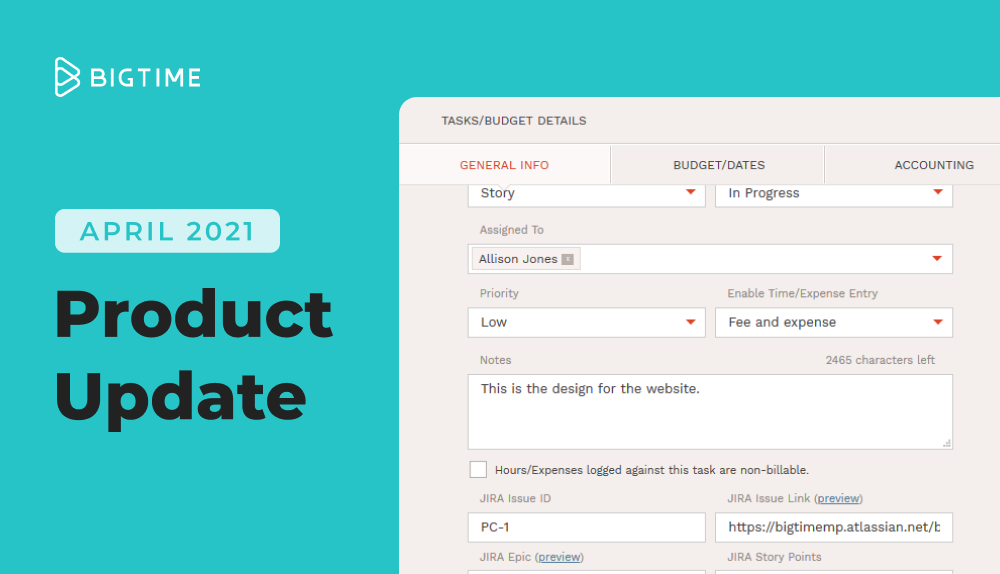Productive is a popular professional services automation (PSA) tool designed to help teams manage projects, budgets, and resources in one integrated platform. While it delivers solid functionality for small to mid-sized agencies, many growing teams and enterprises eventually feel the need for more flexibility, deeper financial oversight, or improved user experience. This is where the best Productive alternatives come in.
In this article, we’ll explore top alternatives to Productive that offer similar or superior capabilities in project and resource management, invoicing, time tracking, and reporting.
Here’s what you’ll find in this guide:
- Why look for alternatives to Productive?
- Must-have features in the best Productive alternatives
- Final verdict on the best Productive alternative.
Why Look for Alternatives to Productive?
Productive is undoubtedly a capable PSA tool, particularly for agencies managing creative and digital work. It brings task management, budgeting, resource planning, and profitability tracking into one place, simplifying workflows for many teams. However, it may not be the best fit for every business model, causing numerous professional services companies to look for alternatives to Productive.io.
Many teams report that Productive’s interface can feel too restrictive as projects scale. Some advanced features like financial forecasting or in-depth reporting come with complexity that can be hard to navigate without training. Its customization options are also limited compared to platforms built for deeper integration or enterprise use.
Moreover, as companies expand into multi-departmental setups or add financial sophistication, Productive’s feature set may fall short. Teams seeking a more scalable, highly configurable, and insights-driven PSA platform often start evaluating Productive.io alternatives.
What Features Should the Best Productive Alternatives Have?
Not every tool labeled as a Productive alternative is a true upgrade. To really move beyond Productive’s limitations, your next PSA or project management tool should come with a comprehensive set of features designed for scale.
Here are the must-have features to look for:
Resource Management
A great alternative to Productive.io should provide drag-and-drop resource planning, skills matching, workload balancing, and forecasting to ensure every hour is optimized and no one is overbooked.
Time & Expense Tracking
Automatic and manual time tracking, expense input, approvals, and billing should be built into the system—not bolted on. Ideally, time data flows directly into financial and productivity reports, providing project managers with live overview of project budget.
Project Management
Tools should support multiple project views (Gantt, tables, lists), custom workflows, templates, and project dependencies to help you manage complex delivery schedules. They should also help project managers oversee multiple project at once and summarize their performance.
Financial Oversight
From budgeting and invoicing to profitability tracking and forecasting, your platform should offer complete financial visibility. The best Productive.io alternatives let you tie every dollar back to specific tasks and resources.
Custom Reporting
Whether it’s resource utilization or revenue per client, strong alternatives to Productive offer visual dashboards, custom fields, and exportable reports to give you actionable insights fast. The best options can also provide customizable templates and multiple views, ensuring that the data is not only available, but also easily understandable.
Integrations & Scalability
Your tool should connect with accounting platforms like QuickBooks, CRMs like Salesforce, or HR systems, while offering permission controls and scalability to match your team size.
10 Best Productive Alternatives
Here’s a quick look at the top Productive alternatives for 2025:
- BigTime – Best overall PSA solution for professional services firms
- Kantata – Built for resource planning and financial control
- Scoro – Combines work, sales, and finances in one platform
- ClickUp – Highly flexible, but requires setup and discipline
- Wrike – Powerful for large teams but complex to implement
- Monday.com – Visually engaging and versatile, though pricey at scale
- Smartsheet – Familiar spreadsheet feel with enterprise features
- Toggl Plan – Simple planning with time tracking, but limited depth
- Workamajig – Focused on creative agencies with strong budgeting tools
- Nifty – All-in-one work hub with modern UI and collaborative features
2025 Productive Alternatives Ranking
While many tools compete with Productive in specific areas, only a few offer the comprehensive, enterprise-grade feature set required for growing service-based teams. We’ve ranked the best ones based on resource planning, project management, financial control, and usability.
| Tool | Description | Strengths | Limitations |
| BigTime | Full-suite PSA for resource, time, finance & reporting | Powerful features, scalable, advanced financials | Steeper learning curve |
| Kantata | Enterprise-level PSA tool | Deep resource & financial planning | Complex setup |
| Scoro | Work, CRM, and finance in one | Business-wide visibility | Expensive for small teams |
| ClickUp | Flexible work platform | Customizable views and automations | Can feel cluttered |
| Wrike | Project-heavy PSA | Built for complex workflows | May overwhelm new users |
| Monday | Easy to use, highly visual | Versatile and engaging | Advanced reporting limited |
| Smartsheet | Spreadsheet-based PM | Great for planners | Less intuitive UI |
| Toggl Plan | Light project & time tool | Very simple and clean | Not ideal for large teams |
| Workamajig | Creative agency-focused | Budgeting and billing tools | Dated interface |
| Nifty | Collaboration and tasks | Modern UI, user-friendly | Missing deep finance tools |
BigTime
Reviews: G2: 4.5, Capterra: 4.6
Pros:
- Offers a full suite of PSA tools, including resource planning, time tracking, invoicing, and reporting.
- Scales with your business, supporting both small teams and large enterprises.
- Real-time data updates ensure all stakeholders are aligned.
- Deep integration options with QuickBooks, Sage, and other tools.
- AI-powered features streamline workflows and automate updates.
Cons:
- Steeper learning curve due to its extensive capabilities.
BigTime is the top-rated alternative to Productive, specifically built to support professional services companies. It combines all the essential tools needed to manage projects, resources, budgets, and time in one streamlined platform. With robust Gantt charts, scenario planning, resource allocation alerts, and comprehensive reporting, BigTime stands out for its depth and flexibility that doesn’t change as your company grows and adds new variables to the equation.
Additionally, BigTime has everything you want to have in a state-of-the-art productive alternative. Project managers benefit from intuitive views and real-time data synchronization, which helps teams stay aligned across every stage of a project. It supports granular time tracking, seamless invoicing, and accurate quoting, making it a powerful solution for firms needing complete visibility into resource utilization and profitability.
Key Features:
- Resource Management: Assign by skills, track availability, and edit allocations via a drag-and-drop calendar. Use AI for demand planning and get notified whenever the system detects any overbooking.
- Project Planning: Build project timelines, budgets, and monitor execution across phases. Forecast profits and utilization rates to ensure that your project is on the right track.
- Time & Expense Tracking: Automated logs with easy export to billing and monitor key project metrics to improve productivity across the board.
- Reporting & Dashboards: Real-time, customizable reports and visual analytics and share them with other project managers for better visibility.
- Invoicing & Quotes: Create branded, customizable invoices and accurate project quotes.
Pricing: Starts at $20/user/month (Essentials), with a free trial available.

Kantata
Reviews: G2: 4.2, Capterra: 4.2
Pros:
- Deep and powerful resource planning capabilities tailored for professional services.
- Advanced project cost management tools that integrate seamlessly with external systems.
- Offers visibility into project margins, resource utilization, and billing.
Cons:
- High barrier to entry with a steep learning curve and complex setup.
- Interface lacks modern polish and can feel outdated.
- Many features require onboarding support and extensive customization.
Kantata (formerly Mavenlink) is a PSA software designed for enterprise-level service organizations, focusing heavily on resource management and financial oversight. With capabilities like demand forecasting, real-time margin tracking, and client-ready invoicing, Kantata provides robust control—but not without a cost.
Unlike more accessible tools, Kantata demands significant upfront configuration. The interface is dated compared to modern alternatives and may frustrate users seeking simplicity and visual clarity. In addition, many features critical for full utilization are available only in higher-tier packages, making it a less attractive option for smaller firms or teams that want a quick deployment. For teams prioritizing sleek UI, intuitive navigation, or faster adoption in their alternatives to Productive.io, it’s likely too complex and rigid.
Key Features:
- Resource Forecasting: Helps managers align talent with project demand through detailed skill mapping and availability tracking.
- Budgeting & Margin Analysis: Tracks project financial health in real time, including planned vs. actual costs.
- Time & Expense Logging: Streamlines entry for employees and approval for managers, integrated directly into billing workflows.
- Project Accounting: Ties deliverables to budgeted time and financial performance.
- Dashboards & Analytics: Offers custom visualizations to support financial and operational decisions.
Pricing: Custom pricing based on features, users, and organizational size. Enterprise-tiered and requires consultation for quotes.
Scoro
Reviews: G2: 4.5, Capterra: 4.6
Pros:
- Combines work management, CRM, and financial features in one platform.
- Strong financial visibility, including profitability and budget monitoring.
- Customizable dashboards and reporting capabilities.
Cons:
- Expensive for smaller teams or startups.
- Can feel bloated due to its wide scope of features.
- Learning curve for teams unfamiliar with complex PSA platforms.
Scoro positions itself as a holistic Productive alternative that unites project management, CRM, billing, and reporting. It is best suited for organizations that want not only task and resource management but also deeper financial oversight and sales tracking in the same system. With integrated CRM and quoting tools, Scoro ensures teams can follow projects from the sales pipeline through to delivery and invoicing.
While its breadth is impressive, this can also be its weakness. The interface can feel heavy, with too many elements crammed into the dashboard, and setting up the system for optimal use often requires professional onboarding. For companies that want simplicity or just project management, Scoro might feel overwhelming and overpriced – and not a good Productive alternative at all.
Key Features:
- CRM & Quoting Tools: Manage leads, proposals, and client relationships alongside project execution.
- Financial Management: Track profitability per project, including expenses and budgets.
- Resource & Time Tracking: Assign work, log time, and create invoices directly from timesheets.
- Reporting Dashboards: Build customizable views for executives and managers.
- Workflow Automation: Automates recurring tasks and notifications for smoother operations.
Pricing: Starts at $28/user/month, making it more expensive than most Productive alternatives. Free trial available.
ClickUp
Reviews: G2: 4.7, Capterra: 4.7
Pros:
- Highly customizable with multiple project views (list, board, Gantt, calendar, timeline).
- Consolidates tasks, docs, whiteboards, and chat in one platform.
- Strong automation capabilities to reduce repetitive work.
Cons:
- Steep learning curve due to overwhelming breadth of features.
- Interface often feels cluttered and unintuitive for new users.
- Advanced reporting, goals, and whiteboards require higher-tier plans.
- Performance issues reported with large workspaces and automations.
In the Productive alternatives category, ClickUp markets itself as the ultimate all-in-one productivity platform, aiming to replace multiple tools by combining task management, documentation, collaboration, and goal tracking under one roof. Its versatility makes it attractive to teams that want maximum control over how they structure their workflows, from agile software teams to marketing departments.
Yet, this strength is also its weakness. The platform can quickly become overwhelming, especially for smaller teams or those without experience configuring complex workspaces. While its free tier makes it appealing for trial use, scaling up usually requires moving into more expensive plans where the most valuable features are locked.
Key Features:
- Customizable Workflows: Tailor statuses, fields, and automations to fit your processes.
- Multiple Views: Switch between list, board, Gantt, and timeline to match project needs.
- Docs & Whiteboards: Create collaborative documentation and brainstorming spaces.
- Automations: Set rules to trigger actions like status changes or task creation.
- Reporting & Dashboards: Monitor performance metrics, though advanced reporting is paywalled.
Pricing: Free plan available. Paid plans start at $10/user/month (Unlimited) and scale to $19/user/month (Business) for advanced features.
Wrike
Reviews: G2: 4.2, Capterra: 4.3
Pros:
- Highly configurable with custom workflows, fields, and templates.
- Multiple project views including Gantt, board, calendar, and table.
- Scales well for larger organizations with advanced security options.
Cons:
- Complex setup and steep learning curve for new users.
- Interface feels cluttered and overwhelming without careful configuration.
- Advanced features such as time tracking and detailed reporting locked in higher-tier plans.
- Can become expensive as teams grow and require enterprise functionality.
Wrike is an established project management platform built for organizations that need detailed planning and oversight. Its versatility allows teams to create custom workflows, handle multi-stage approvals, and manage projects with robust Gantt charts and dashboards.
However, Wrike is not beginner-friendly, which makes it less than perfect alternative to Productive.io. Its interface often feels dense, and onboarding requires a significant time investment to unlock its potential. Many of the features that make Wrike powerful, such as advanced reporting and workload balancing, are not available in the lower plans, forcing teams into premium tiers. For small teams or those seeking a straightforward PSA tool, Wrike’s complexity can feel like more of a burden than a benefit.
Key Features:
- Custom Workflows & Fields: Define detailed processes and adapt them to team needs.
- Multiple Views: Switch between Gantt charts, Kanban boards, calendars, and tables.
- Proofing & Approvals: Built-in tools for creative and formal review cycles.
- Dashboards & Reports: Visualize project data, though most advanced reporting requires premium tiers.
- Integrations: Connects with hundreds of tools, including cloud storage and communication apps.
Pricing: Free plan available. Paid plans begin at $9.80/user/month (Team) and scale up for Business and Enterprise tiers.
Monday.com
Reviews: G2: 4.7, Capterra: 4.6
Pros:
- Attractive, visual boards that are easy to understand.
- Flexible workflows with multiple project views.
- Strong integrations with Slack, Zoom, Google Drive, and more.
Cons:
- Can become visually cluttered with too many columns or boards.
- Reporting and workload management are limited on lower-tier plans.
- Pricing increases significantly as advanced features are unlocked.
- Lacks depth in financial oversight compared to PSA-focused platforms.
Monday.com is widely known for its colorful and intuitive interface, making it one of the most recognizable Productive alternatives. Its boards and multiple view options—such as Kanban, timeline, and calendar—allow users to organize projects in whichever way suits them best. The platform’s automations and integrations also help centralize work across tools.
That said, Monday’s simplicity comes at a cost. As projects grow, boards often become cluttered and harder to manage, creating inefficiencies. More advanced capabilities like workload tracking, financial visibility, and deeper reporting are either limited or hidden behind expensive tiers. For service-based organizations seeking profitability and resource management insights, Monday often feels too lightweight.
Key Features:
- Boards & Views: Manage projects with Kanban, calendar, and Gantt-style views.
- Automations: Create rules to update statuses and assignments automatically.
- Integrations: Connect with communication and storage platforms for centralized workflows.
- Dashboards: Visual summaries to monitor project health and progress.
- Templates: Pre-built project layouts to speed up setup.
Pricing: Free plan available. Paid plans start at $9/user/month (Basic) and $12/user/month (Standard), with more advanced features offered in Pro and Enterprise tiers.
Smartsheet
Reviews: G2: 4.4, Capterra: 4.5
Pros:
- Familiar spreadsheet-style interface, easy for Excel users to adopt.
- Multiple project views, including grid, Gantt, and calendar.
- Handles large datasets effectively for detailed planning.
Cons:
- Interface can feel rigid and outdated compared to modern tools.
- Steep learning curve for non-spreadsheet users.
- Advanced features like resource management and reporting require higher plans.
- Less engaging for visual, collaboration-focused teams.
Smartsheet is a Productive alternative designed for teams that prefer detailed, spreadsheet-like control over their projects. Its grid-based system allows users to manage tasks, project budgets, and resources with familiar formulas and linking features. For organizations transitioning from Excel, Smartsheet provides a more structured and scalable solution without losing the spreadsheet feel.
Still, Smartsheet has notable drawbacks. Its interface is less modern and engaging than newer project management tools, and it requires time to set up and maintain effectively. Additionally, many of the advanced features—such as resource allocation and advanced reporting—are only available at premium tiers.
Key Features:
- Grid, Gantt & Calendar Views: Multiple ways to manage tasks and projects.
- Formulas & Cell Linking: Brings Excel-like functionality into project management.
- Automation Rules: Streamlines repetitive tasks and approvals.
- Dashboards & Reporting: Visualizes data with charts and summaries.
- Resource Management: Available in higher tiers for workload balancing.
Pricing: Paid plans start at $7/user/month (Pro). Business plans begin at $25/user/month, with advanced features in Enterprise tiers.
Toggl Plan
Reviews: G2: 4.3, Capterra: 4.6
Pros:
- Simple, clean interface that is easy to learn.
- Timeline and calendar views make planning intuitive.
- Seamless integration with Toggl Track for time tracking.
Cons:
- Lacks advanced features like budgeting, invoicing, or forecasting.
- Not designed for large or complex projects.
- Limited reporting and analytics compared to PSA tools.
- Resource management is too basic for scaling organizations.
Toggl Plan is a Productive alternative built for small teams or freelancers who need a straightforward planning tool without unnecessary complexity. Its drag-and-drop timelines and clear task assignments make it perfect for keeping projects organized at a high level. When paired with Toggl Track, it covers both scheduling and time tracking in a lightweight package.
That said, Toggl Plan is not a replacement for a full PSA or advanced project management system. It doesn’t include financial features, in-depth reporting, or scalable resource management. For growing organizations with complex workflows, Toggl Plan often feels too limited, making it more of an entry-level solution than a true alternative to Productive.
Key Features:
- Timeline View: Drag-and-drop scheduling with color-coded tasks.
- Assignments: Clear roles and responsibilities for each team member.
- Milestones: Track important deadlines and deliverables.
- Toggl Track Integration: Syncs directly with Toggl’s time tracking tool.
- Collaboration Tools: Basic commenting and file attachments.
Pricing: Free plan available. Paid plans start at $9/user/month for the Team plan.
Workamajig
Reviews: G2: 4.0, Capterra: 4.1
Pros:
- Strong financial tools for budgeting, billing, and client invoicing.
- Integrates CRM, project management, and accounting in one system.
- Provides detailed visibility into project profitability.
Cons:
- Outdated interface that feels clunky compared to modern tools.
- Requires lengthy onboarding and training to use effectively.
- Complex setup, with many features hidden behind customization.
- Not flexible enough for industries outside creative and marketing.
Workamajig focuses on the unique needs of creative agencies, making it a specialized solution rather than a general-purpose PSA tool. It combines project management, CRM, and accounting features into one platform, allowing agencies to manage client relationships, track billable hours, and generate invoices from the same system.
However, Workamajig’s design shows its age, and its usability lags behind modern Productive alternatives. Many users report a steep learning curve, and setup often requires professional assistance. While it delivers financial and billing control, the platform lacks the sleek, intuitive user experience expected today. Agencies willing to trade aesthetics and ease of use for accounting depth may find value here, but others may find it limiting.
Key Features:
- CRM Integration: Manage leads, proposals, and client relationships in the same platform.
- Budgeting & Billing: Track expenses, margins, and generate client invoices.
- Project Accounting: Monitor profitability at the project and client level.
- Time & Expense Tracking: Record billable hours and link them to invoices.
- Resource Scheduling: Assign creative teams and track workload.
Pricing: Custom pricing available, typically quoted based on agency size and features required.
Nifty
Reviews: G2: 4.7, Capterra: 4.8
Pros:
- Clean, modern interface with fast onboarding.
- Combines project management, chat, docs, and milestones in one platform.
- Easy-to-use collaboration features for distributed teams.
Cons:
- Lacks advanced financial tools like budgeting and invoicing.
- Reporting and analytics are less robust than PSA-focused tools.
- Not ideal for large enterprises with complex resource management needs.
- Limited integrations compared to competitors.
Nifty is a modern work management platform designed to keep teams connected and projects moving forward. Its simple interface and all-in-one approach make it appealing for distributed teams that need task management, communication, and documentation in a single workspace. With milestone tracking, built-in team chat, and collaborative docs, Nifty reduces the need for multiple disconnected tools.
Still, while Nifty shines in usability, it falls short on depth. It lacks the financial oversight and advanced reporting found in stronger Productive alternatives, making it unsuitable for firms that rely heavily on profitability tracking or advanced resource management. Larger organizations may also find its integrations too limited to replace more established PSA tools.
Key Features:
- Milestones: Visualize project progress with goal-oriented tracking.
- Team Chat: Built-in communication channels to reduce tool switching.
- Docs & Collaboration: Create and share project documents directly within Nifty.
- Task Management: Organize work using Kanban, calendar, and list views.
- Client Portals: Allow external stakeholders to track project status.
Pricing: Free plan available. Paid plans start at $5/user/month, making it one of the most affordable Productive alternatives.
Which Productive Alternative is the Best?
After reviewing the top Productive alternatives, it’s clear that while many tools offer specialized strengths, most come with trade-offs in complexity, missing financial features, or limited scalability. Still, there is one Productive alternative that brings much more to the table.
BigTime stands out as the most complete alternative to Productive. Unlike other platforms that either excel in one area or require heavy customization, BigTime offers an integrated suite of project management, time tracking, resource planning, and financial oversight features built specifically for professional services. Its advanced reporting, automated workflows, and seamless integrations ensure businesses can track every hour, dollar, and resource with precision.
If your team is ready to move beyond the limitations of Productive, BigTime is the clear choice. See it for yourself by booking a weekly demo or starting a free trial today, and discover how BigTime helps firms deliver projects on time, on budget, and with complete confidence.




